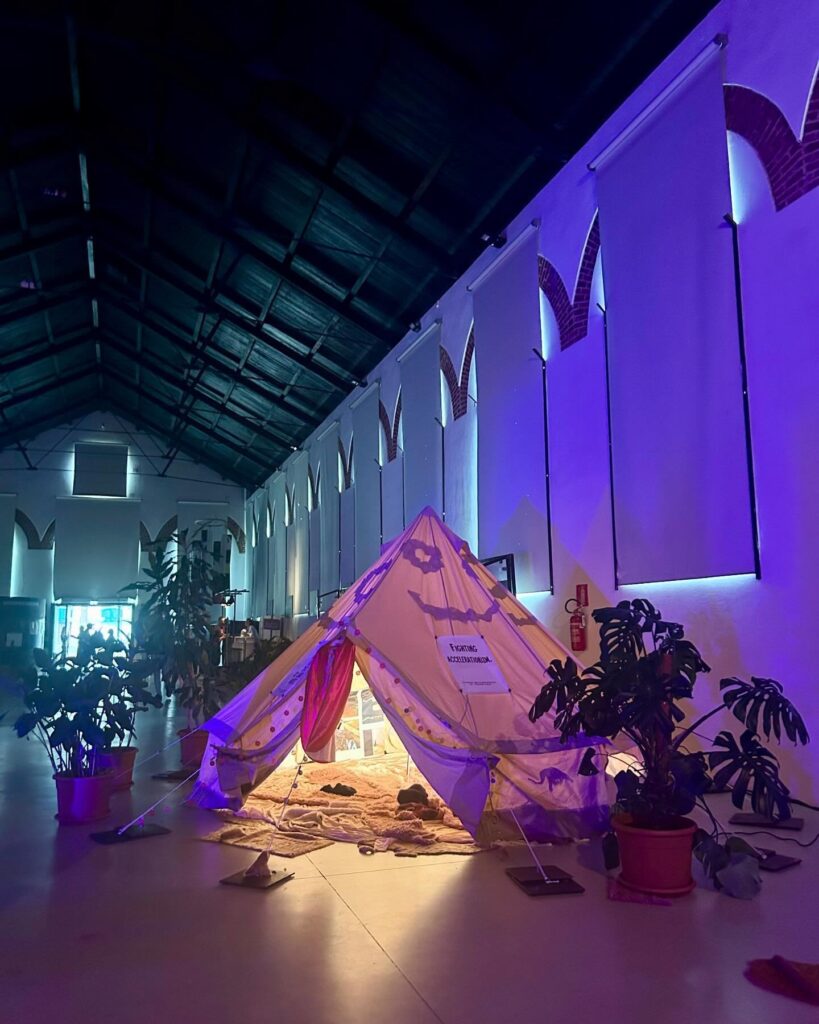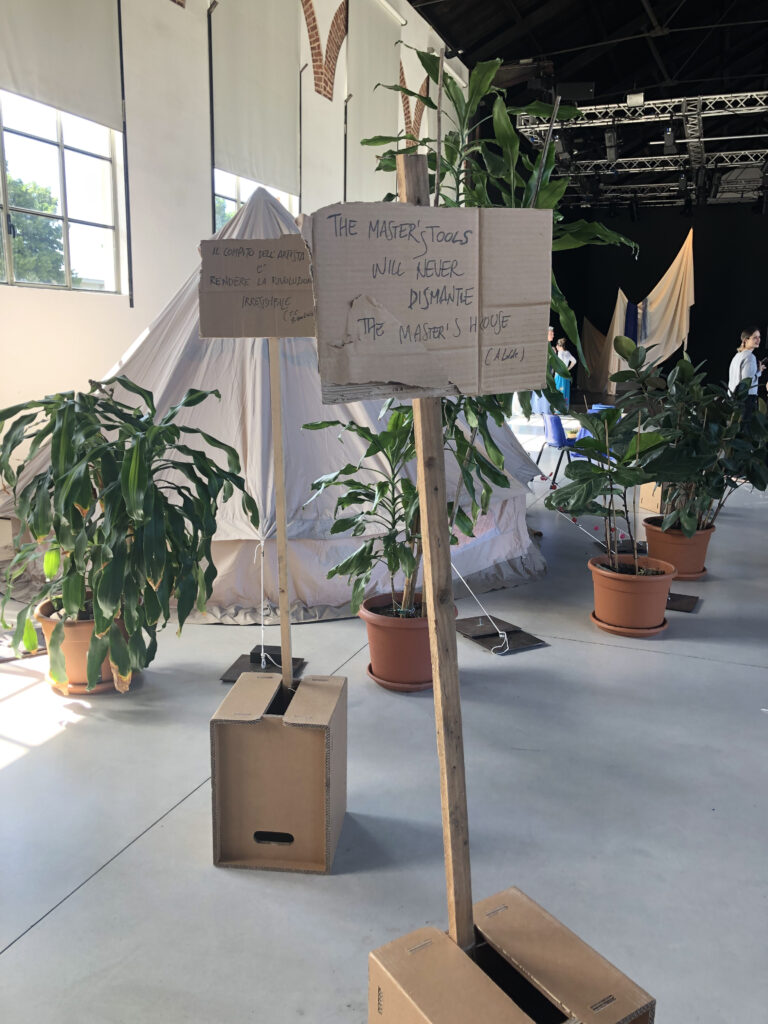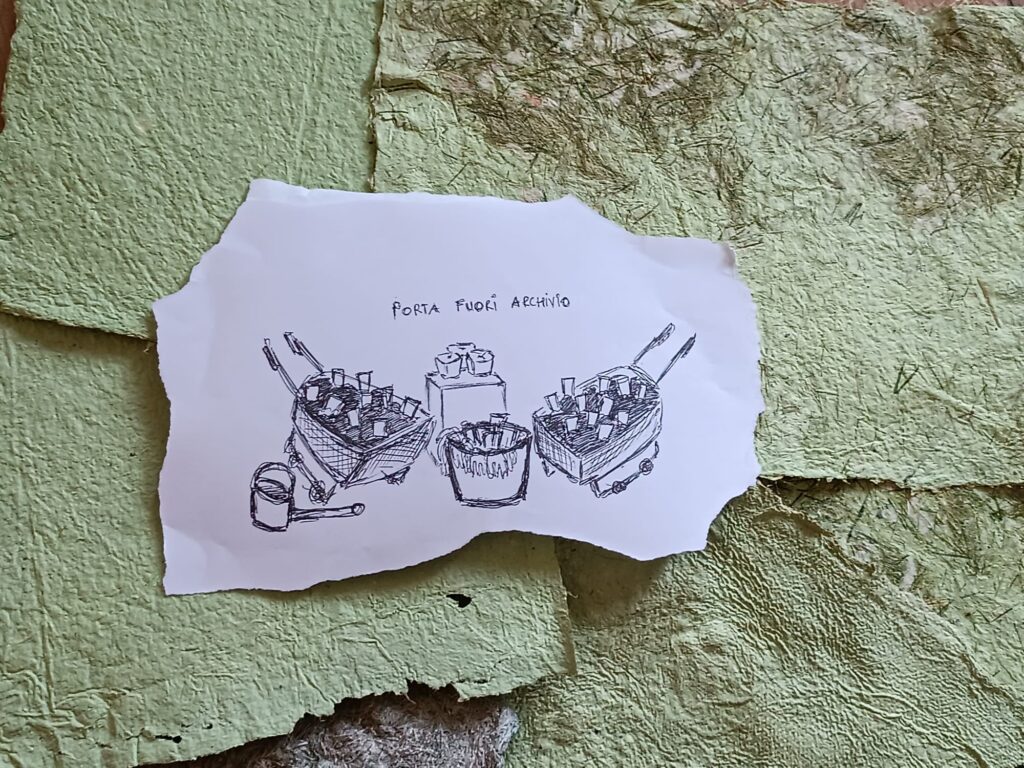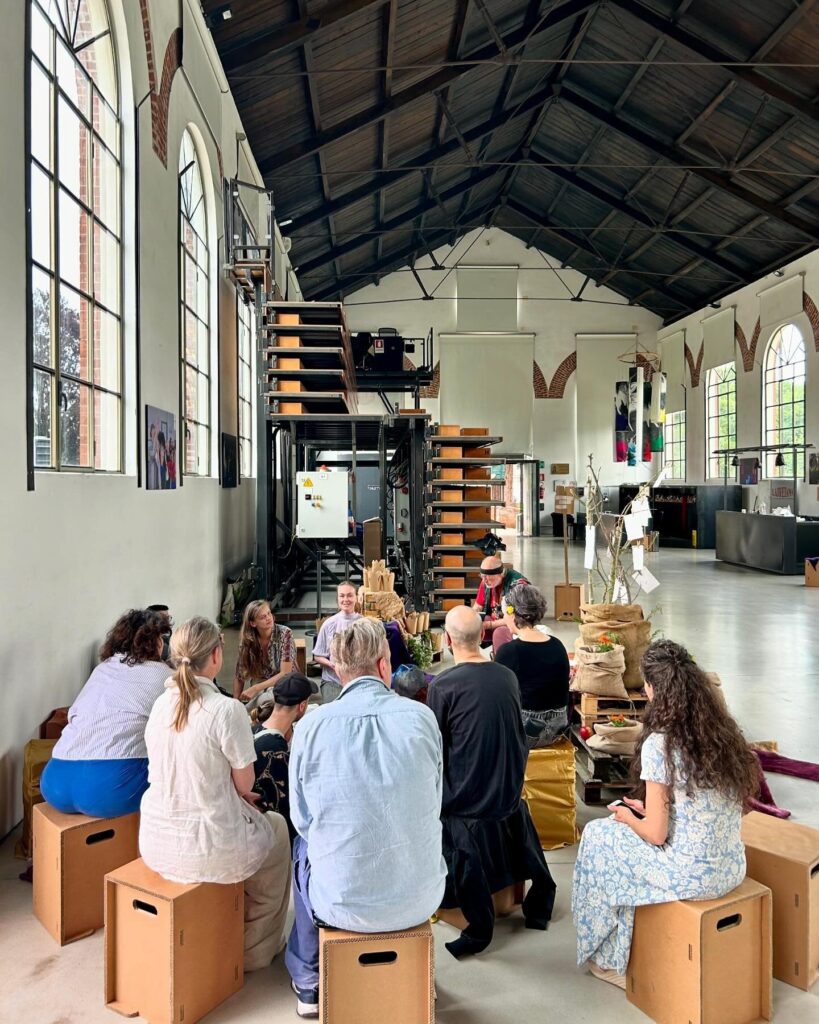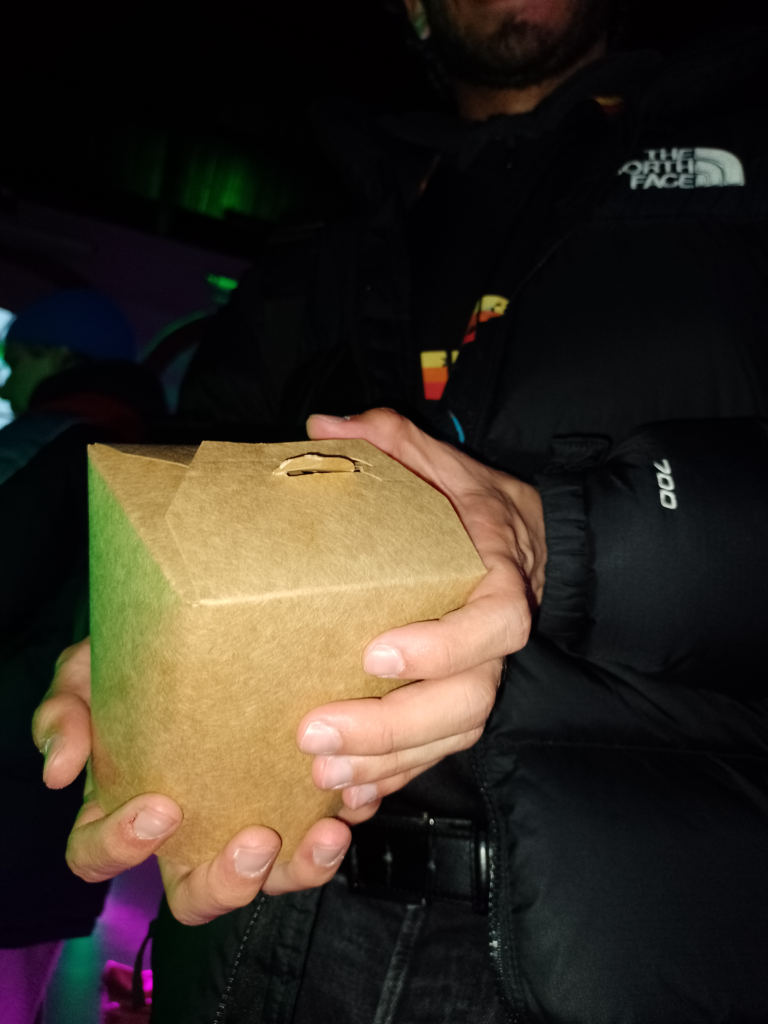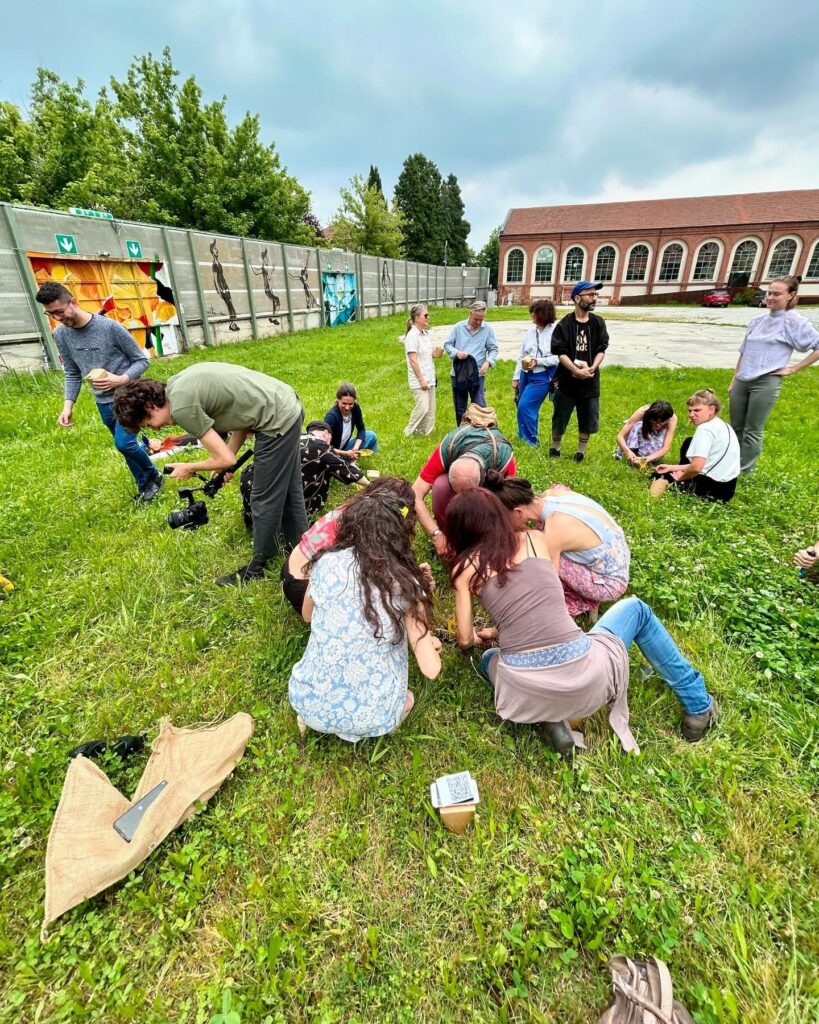ON MOBILISATION OF CARE
Exhibition
- Eugenia Coscarella
- Alessio Mazzaro
- Kadri Sirel
- Fiona Winning
The International Exhibition
ON MOBILISATION OF CARE
Lavanderia a Vapore, Collegno, Torino, Italy
May 29 – May 31, 2024
The exhibition took place at Lavanderia a Vapore from May 29 – May 31, 2024, investigating the theme of mobilising imaginaries and bodies to generate collective actions for alternative political scenarios. This topic was explored by presenting two artistic devices co-created by an international duo of artists with mixed backgrounds, generating convergences of artistic languages that blurred traditional genres while proposing alternative forms of engagement. Both artworks were based on scores that required public participation to be activated and to function, enacting mobilisation beyond merely thematising it.
Alessio Mazzaro (IT) and Fiona Winning (UK)
DO NOTHING CLUB
Alessio Mazzaro is a visual artist, director, and story researcher. He works on the border between performer, spectator, and witness, investigating the agency of the citizen in the public space, in both reality and art.
Fiona Winning is a visual artist interested in the possibilities that arise from meetings and the inclusion of others in the research and discussion about how it feels to live in this world.
Through a collaborative organisational process, the two artists invite the public to enter the Do Nothing Club, a protected and transitory space where people can “do nothing”, stop, and remain inactive for as long as they want, creating a collective solution against hyper-productivity. The Do Nothing Club is a crowded space filled with costumes, white noise, sleeping masks, lavender, posters, and voices. It aims to create a widespread community of caring, reclaiming time individually and collectively. Between idleness sessions and collective conversations, participants confront the exhaustion that art practice can bring.
Kadri Sirel (EE) and Eugenia Coscarella (IT)
TAKE AWAY ARCHIVE
Kadri Sirel is an Estonian choreographer, performer, and artist researcher whose often site-specific projects address the topic of production. Whether it’s self-production, the production of meanings, values, or products, she works with the dancing body to investigate the tension between individual and societal desires. Her methods include improvisation and somatic practices, documentation, and co-creation to reimagine the value of dancers’ labor within capitalism. She graduated from the Viljandi Culture Academy Dance Art department (EST) and holds a Master’s degree from the Home of Performance Practices at the ArtEZ University of Arts (NL).
Eugenia Coscarella is a contemporary dancer who graduated in Performing Arts with a thesis on the importance of the artistic experience for the human being and also in dance-theater from Fondazione Milano Teatro Paolo Grassi. As a dancer performer, she has worked with Sioned Huws, MK/Michele Di Stefano, Gruppo Nanou, Zaches Teatro, and the Trisha Brown Dance Company. Since 2014, she has been teaching dance to children, adolescents, and adults. Since 2015, she has been a choreographer and trainer for the Passi di Luce theater company, which is composed of children, adolescents, and adults. She develops personal research on the relationship between dance and performance by collaborating with visual artists, sound artists, and poets. She is the author of the choreographies: Play with Trisha (2014), Yaku Shin in a Hall (2015), Blind Date (2017), and Gift from the Sea (2019). In 2019, she founded P.A.D. research, an association that proposes educational and performance projects on the relationship between contemporary dance and performance languages.
The two dancers gathered their knowledge of bodies and lived experiences around the idea of archiving: how to map and transmit ephemeral phenomena or processes? How to take away learnings from experiences that can inform the future? How to learn from our history and turn this into a collective action to invent the future and bring about change? Starting from these questions, they created an archive as a growing installation that changed day by day thanks to the contributions of visitors. Combining the contemporary habit of take-away food with a deep connection to the vegetal realm, the installation revolves around a tree with seedable papers hanging, surrounded by cardboard take-away boxes, gardening tools, gardening soil, and a letter with a score to activate the archive. Visitors are invited to sit around the archive and reflect on the question: what would you like to get your hands dirty for? This call for dreams and action is followed by an invitation to write down the answer and collect in the boxes all the necessary items to go out in nature and plant the purpose, mapping it with a QR code to be shared with the artists. In the future, they will map this growing landscape of desires seeded by the visitors who will affect the future. The archive as a place of encounter, where wishes, memories, and experiences unfold an archaeology of the future.
***
The exhibition enacted the principle of mobilisation and mirrored the notion of embodied knowledge developed with the curatorial approach of the symposium by hosting two interdisciplinary artworks that offered scores and experiences. Coherently with the thematic frame, it became a living process in development. This time-based nature required a change in the planned timeframe: the seven-day arc was functional to traditional engagement for visitors passing by, while the consistent engagement and needed facilitation from the involved artists implied a more punctual intervention: shorter in time but deeper in engagement and qualitative exchange. Moreover, the shortening of the exhibition corresponded to an extension of the symposium duration to align their timing and have both simultaneously for people to attend each format, cross-pollinate one another, and enhance mutual learning. This new exhibition format allowed for more qualitative participation, not only in terms of the time spent and the contributions given by each visitor but also by providing collective experiences and spaces for encounters that are rarely welcomed by traditional exhibitions, which mostly offer curated paths or guided tours and regulated spaces for art products.
The exhibition challenged the object-based approach and related to the theme of mobilisation by engaging visitors directly, whose participation was the main trigger for the artwork activation. People were not invited to see but to act, sweeping away the illusion of art as a permanent and closed product, and instead re-centering the living experience as a fundamental value in a fast-changing world—multiple, nuanced, and complex, and often ungraspable with traditional tools. The curation offered a context where content was generated by people’s contributions, opening an organic process where spaces and artworks changed daily thanks to the use, contributions, and exchanges with people who could add or take away elements to the artistic works.
This open-ended nature potentially expands the exhibition timing since it offers a score for a growing archive that provides the ground for potential follow-ups of the seeded results and proposes scalable artworks to be presented again, mapping the transformations through different responses over time. Both works related to the theme of reinventing an alternative political scenario through desires and dreams, dismantling the exploitative paradigm of exhaustion, or digging into our call for change and practicing an archaeology of the future. They often provided collective actions and moments to reclaim the power of sharing and collaborating in reverse of the individualisation of the social body we currently witness.


